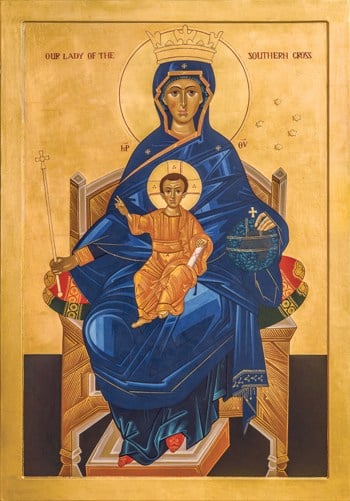
Australia has a new image of Our Lady of the Southern Cross and it has Catholics with an Anglican patrimony and background and the seasoned Central Coast-based iconographer Michael Galovic to thank for it.
The work was commissioned by the Personal Ordinariate of Our Lady of the Southern Cross, which came into being in 2012 after Pope Benedict XVI invited groups of Anglicans to enter the Catholic Church while retaining their Anglican patrimony.
The unique structure was also created with a view to attracting new followers to Christ – a view bolstered by Pope Francis’ appointment in November of a bishop to head the ordinariate in the US – as well as welcoming interested former Anglicans who have become Catholic, and possibly – should they wish it – other Catholics who have not yet completed all of the rites of initiation, usually concluding in the Roman Catholic Church in Australia with Confirmation.
(The ordinariate also reports attracting a small but enthusiastic number of mainstream Catholics who prefer its liturgy and close-knit community life.)
The commissioning of the icon was part of the ordinariate’s desire to have its own unique imagery, drawing on the wealth of its English ecclesial heritage and its Australian surrounds while also embracing the iconographic tradition which emerged largely in the Orthodox East.
Speaking to The Catholic Weekly from his workshop while waiting for the right moment to apply some resting gold leaf, Mr Galovic, 66, said it had been a pleasure working on the idea for the icon with Fr Stephen Hill, an ordinariate priest based in Newcastle.
The final result, he says, is not a work of art.
It is deliberate distortion of human bodies and geometry – a surrealist blurring of form and theology – unveiling the mystical reality of that which it depicts.
Whereas Caravaggio and others produced attractive, life-like figures – often repairing to brothels to source models for their female figures – the icon painter endeavours to depict a theological reality utilising the rich symbolism consonant with an already-existing tradition.
“There is a Chinese proverb saying that one can paint a forest and trees, but not the wind and the breeze passing through it; one can paint the sea, but not the roaring sound of waves; one can paint a man, but not his soul,” Galovic said.
“Well, icons endeavour to do precisely that, to paint the seemingly impossible, to depict the unknown and unknowable, the mystical and elusive to all senses. Hence their immense power and presence in so many churches and shrines, chapels and also private abodes and dwellings all around the world.”
Emigrating to Australia from the Balkans 26 years ago, he has been perfecting his participation in icon making for the past 46 years.
He says he has tried to evade categorisation but finds himself, more and more, to be following in the broadly-named Russian tradition of ever greater purity and clarity in icon painting (the Greek tradition typically being more life-like in its depictions).
His ordinariate icon was officially blessed on 24 January in Perth by the leader of the Australian Ordinariate, Mons Harry Entwistle, in the church of St Ninian and St Chad where it will reside.
The past six months have been a momentous time for the ordinariate, which operates as a non-territorial diocese with 10 parishes spread throughout Australia, with its own congregations and priests.
Mons Entwistle recently attended the installation of his US counterpart, Bishop Steven Lopes, a former Vatican doctrinal official and the first bishop to be installed as an Ordinariate leader – a sign of confidence and hope in the fledgling ecclesial initiative.
The ordinariate missal, detailing the feasts and order of the unique ordinariate liturgy, was released in November.
Cardinal Robert Sarah, the Vatican’s prefect for the Congregation of Divine Worship and the Discipline of the Sacraments, is known to admire the ordinariate liturgy, floating the idea of adding an ordinariate option in the appendix of the Roman Missal.
Mons Entwistle told The Catholic Weekly last month that the liturgy was largely based on the 1549 Book of Common Prayer which included pre-Reformation elements from the Sarum liturgy which had been lost to the Catholic Church.
“What, in fact, I think will happen is that this missal – the Divine Worship Missal – will be a kind of influence on future reforms of the Novus Ordo (the contemporary Roman Catholic Mass),” Mons Entwistle said, adding that the lay people and priests who stepped forward in faith to join the Catholic Church had been surprised and bolstered by God along the way.

“In spiritual matters you have to actually be committed to God’s will before you learn what it is.
“It’s been like that with the ordinariate. Those who were committed to the vision came in and are now part of its development whereas those who wanted to analyse and cross every thing didn’t come in, complaining (for the lack) of all the things that have now been put into place.
“It’s like that with spirituality more generally. People will say ‘well, if I knew what God’s will was, well, then I’d do it’.
“No. You must be committed to God and then discover what His will for you is.”
For information or prints, visit ordinariate.org.au or call 02 4968 2428.
